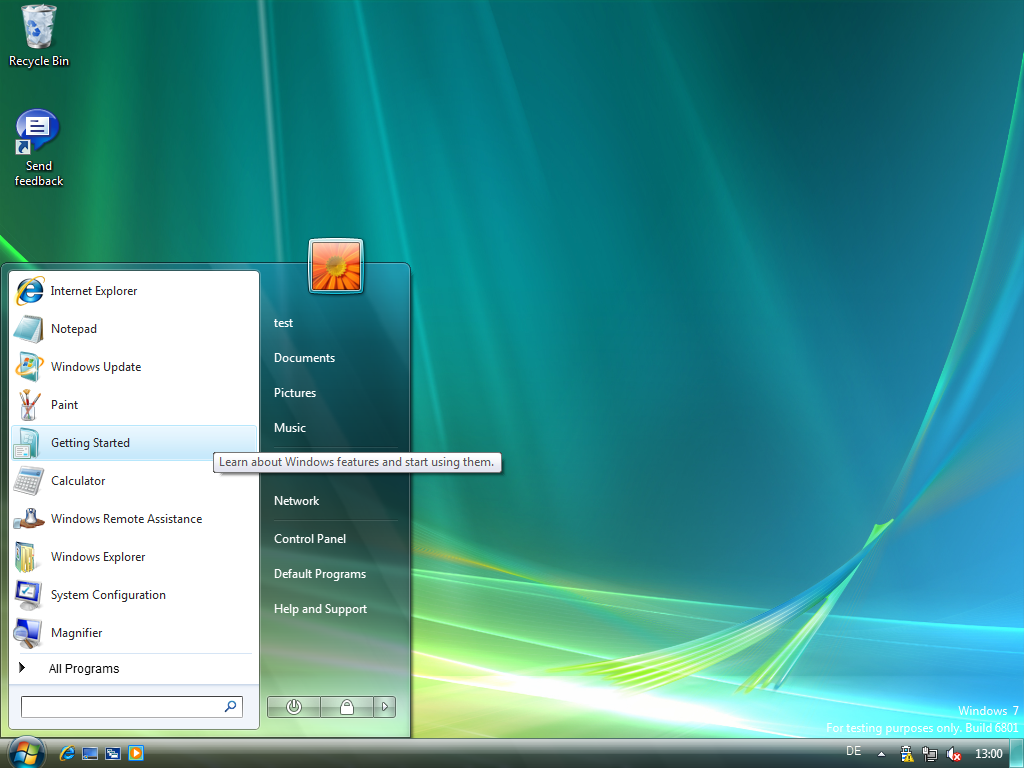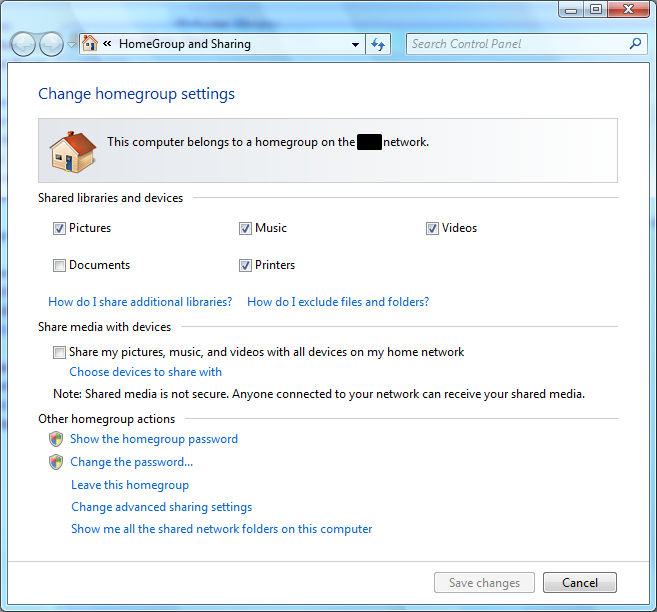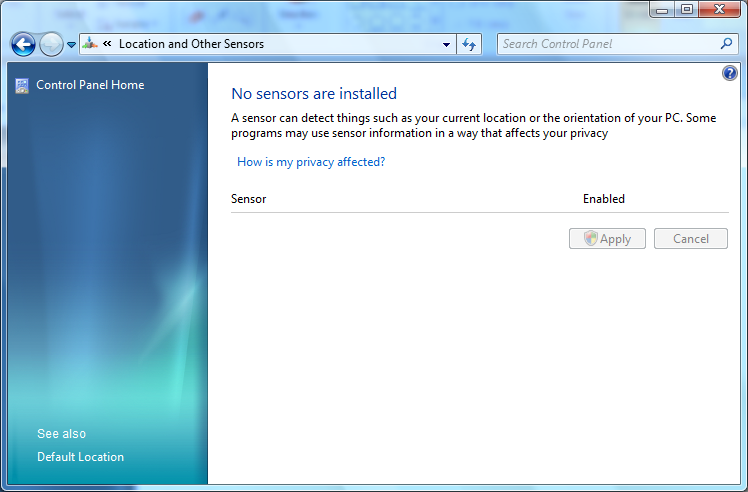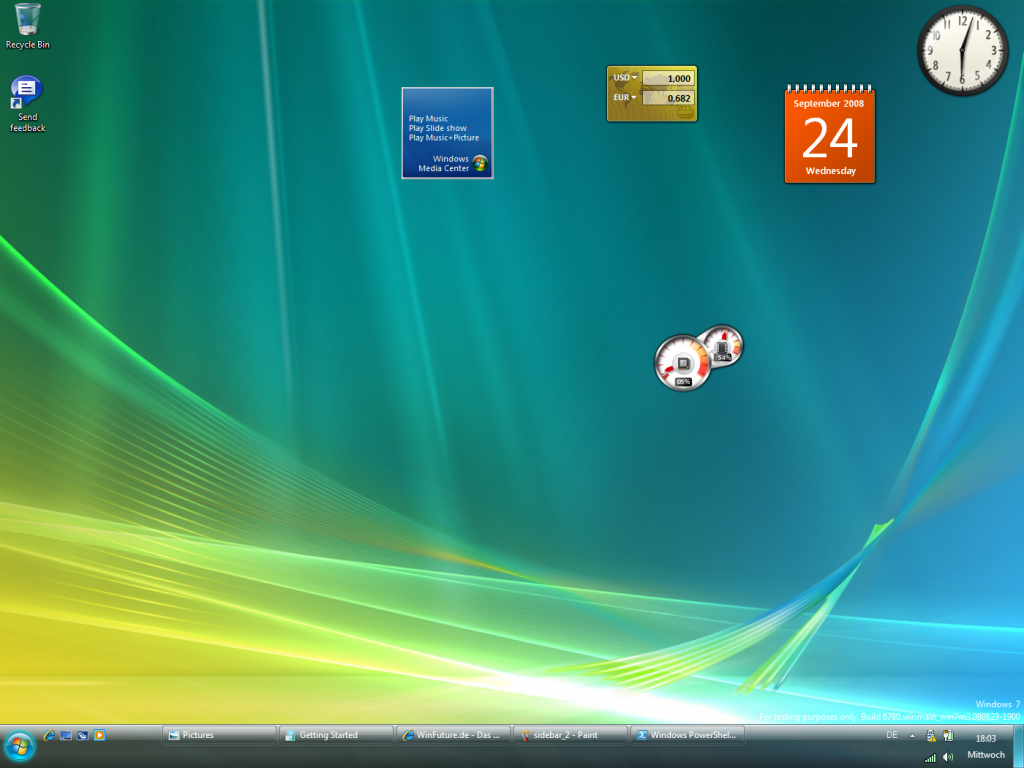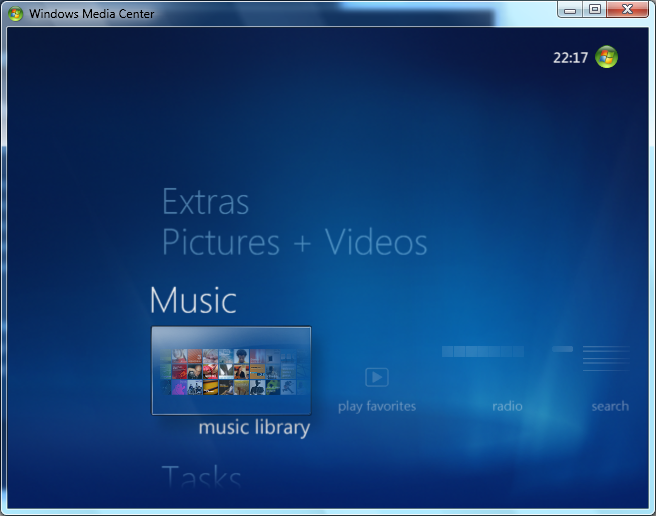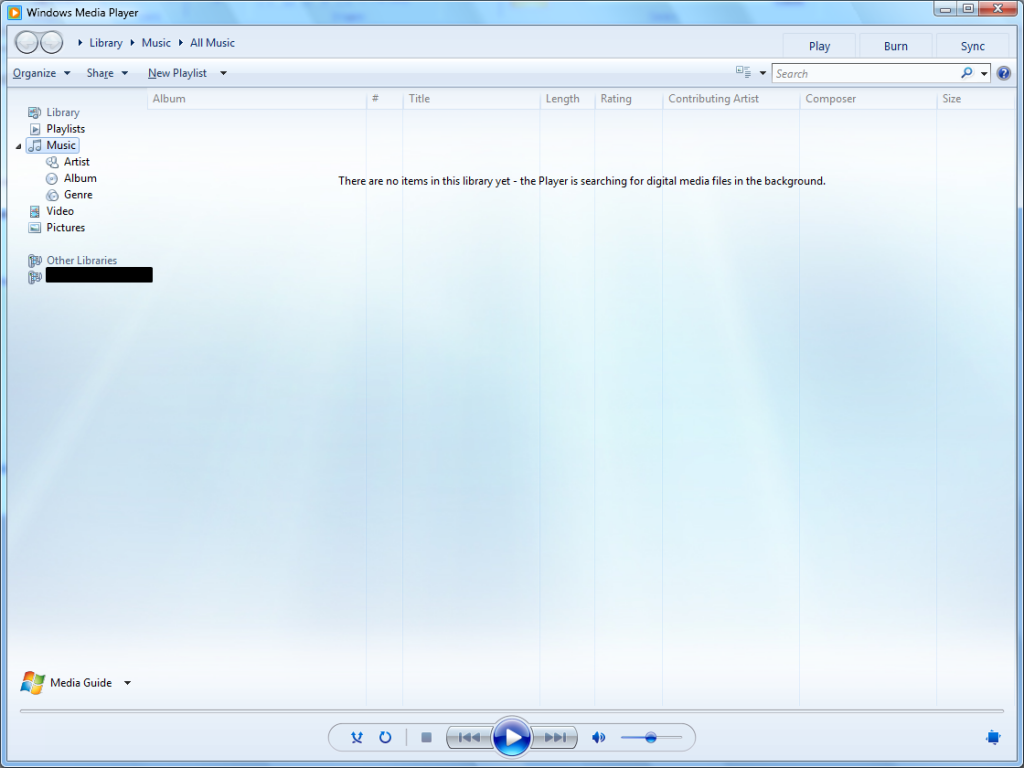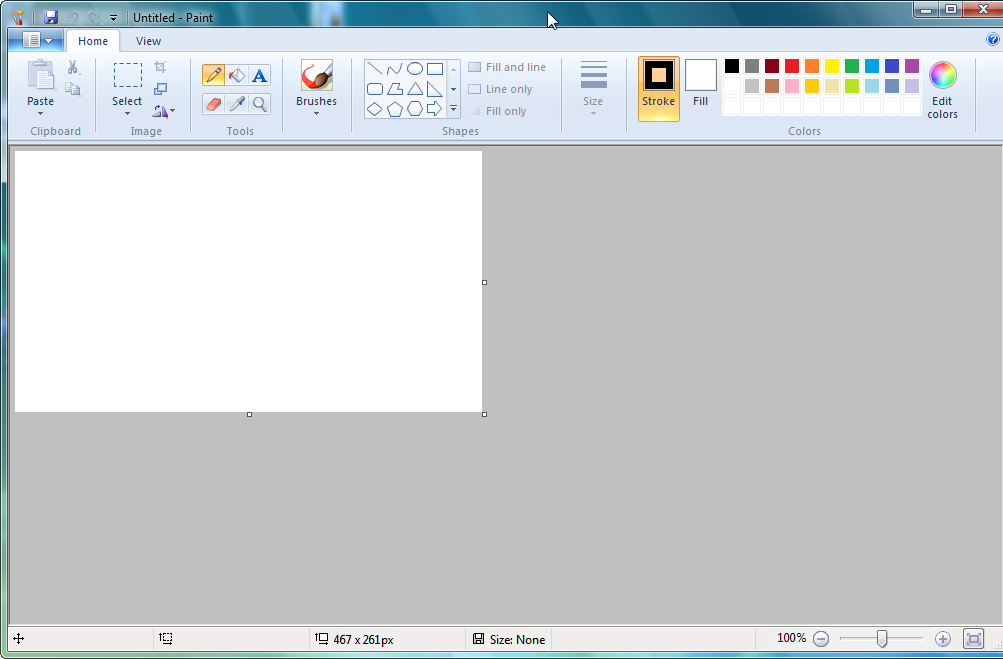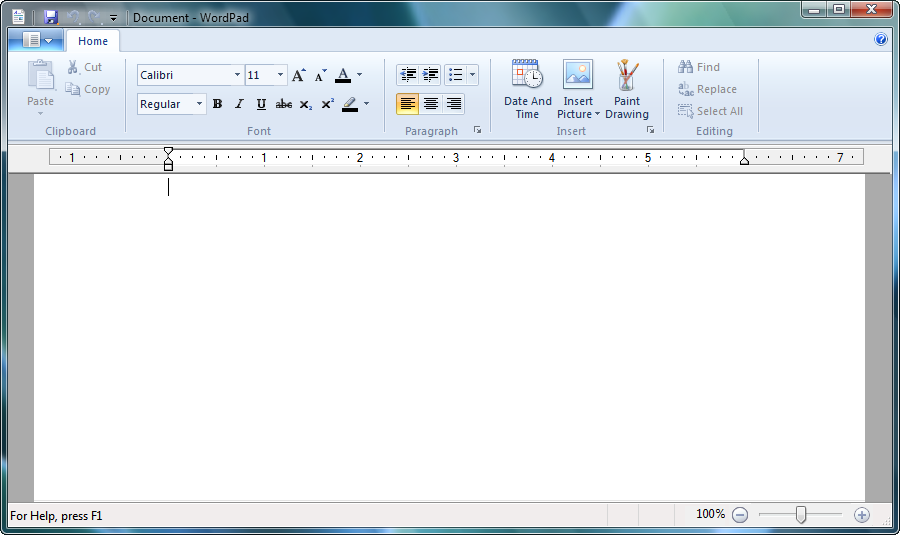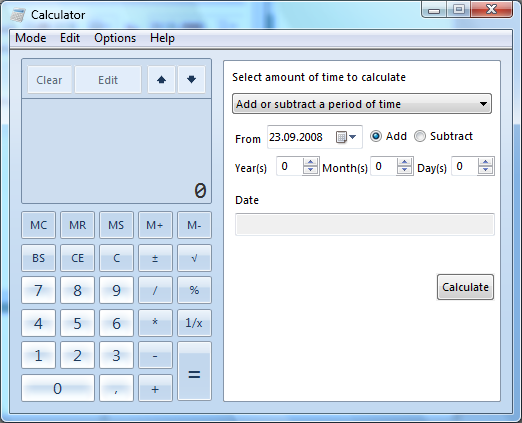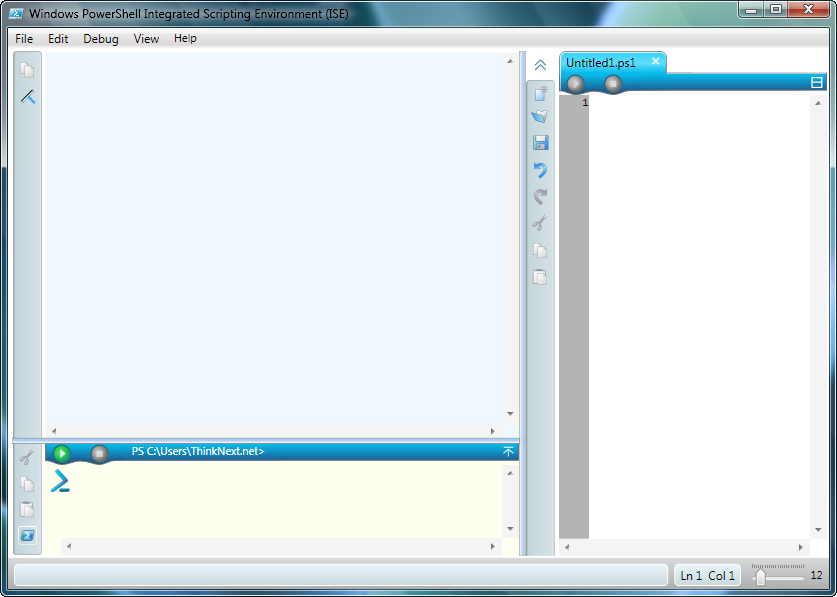Windows 7: Looking ahead at PDC
What can we expect to see of Windows 7 at the upcoming Microsoft Professional Developers Conference (or PDC) next week? I take a sneak peak at some of the features or improvements leaked, discussed or presented the last couple of weeks. This list isn’t accurate as Microsoft has deliberately been quiet about Windows 7 and its main features. Expect to hear about most of the following article next week when Windows 7 is officially uncovered to developers, IT pros, the press and the rest of the public at Microsoft PDC 2008!
Will Windows 7 get a cool new user-interface in terms of graphical overhaul?
Nope. Microsoft did officially state they won’t be changing the UI a lot (like they did when moving from Windows XP to Windows Vista) as, although very cool, most people get scared when seeing a new UI. The average user or users with less computer experience had some trouble adapting to the (rather minor, in my opinion) changes Windows Vista brought. So be prepared to be let down when it comes to the graphical appearance of the system itself if you were expected something better / newer / nicer. They are however putting some effort into making the experience more uniform across the system.
I hate User Account Control (UAC) in Vista! Are they going to change that at all?
Nope. UAC as designed is a basic security and permissions/access design that should be implemented in every modern day operating system. Linux and Mac OS X have had this design for ages now, separating users from admins and raising privileges on the spot when needed. In some of the latest leaked screenshots, it showed Microsoft is however working on refining the user experience when using User Account Control. It showed a configuration panel allowing the user to set when and how the user should be notified of UAC notifications. Also note that Microsoft is very much paying attention to the general public on this issue. Based upon user input when Vista launched, Microsoft refined UAC in the Windows Vista Service Pack 1 release.
Will Windows 7 have a completely new and rewritten kernel powering the OS giving us more power?
Nope. Microsoft stated on their official Windows 7 blog they won’t be bringing a brand new kernel to the system as it’s simply not needed. The current NT kernel is just fine and, although people like to think otherwise, is fairly fast. They (Microsoft) did say they are brining improvements to the kernel as always. One should also consider the compatibility issues created when changing some as fundamental as the Windows kernel itself.
Source: windowsvistablog.com
So when is this secret OS coming out?
No one really knows of course but lately there have been some rumors on the interwebs that Windows 7 would be landing just before the summer of 2009. Personally I think a Q4 CY2009 (November enterprise/business launch, January 2010 consumer launch) is more realistic. Then again they should really try to get this to the OEMs before the holiday seasons as missing that launch window with Windows Vista did in fact hurt sales.
This doesn’t seem to be a big thing.. Windows Vista R2?
Well yes and no. A lot of people I talk to say Windows 7 is going to be a slight update and call it Windows Vista R2 (after the naming convention of Windows Server updates) and state Windows 7 won’t bring drastic new features to the table. Microsoft disagrees and call Windows 7 “a major release” in the Windows product line deserving a X. release rather than a .X release. Yes it’s true Windows 7 won’t change that much compared to its older brother Windows Vista. The change in name is more of a marketing stunt to get rid of the bad name the press has given Windows Vista (more on that in the closing statement). It’s a good move made by Microsoft and it also comes in line with the yet-to-release Windows Mobile 7. It sets a new image and a clear image for the freshly (on some people opinion: slightly) updated Windows.
I know a feature officially announced, ha! Multi-Touch input!
And you are right! Windows 7 is bringing multi-touch input in a consumer based operating system to the masses. At All Things Digital this year, Microsoft chairmen and CEO Bill Gates and Steve Ballmer gave a small demo showing the typical multi-touch features found on other devices (Apple iPhone, modern laptop touchpads) such as pinching and navigating a maps using multiple fingers. How Microsoft will implement the new style of input is still anyone’s guess. If I’m correct (and I’m not an Apple developer what so ever), Apple uses a gesture recognition system that takes away the complexity of handling multiple events. Of course this won’t always work in a operating system environment where developers need to use more options than just gestures. Again .. I’m not sure on how Apple is doing it, but anything multi-touch is really hard. Almost every input system relies on the input cursor being at one spot at the screen with a X and Y coordinate. Multi-touch changes all that as there will be multiple points of contacts. Then again Microsoft had a pretty cool training ground: Microsoft Surface.
Source: ATD
It is however important that Microsoft brings rich new APIs to the system allowing developers to easily make use of the new hardware features. For small time developers or system architects who want to get going quickly without messing about with input methods, Microsoft should provide a gesture-based interface with a set range of gesture commands to be inputted put into the apps. For more advanced developers such as game creators, Microsoft should allow direct access to the input itself allowing developers create amazing stuff and not being limited by the built-in gesture recognition system.
Dell has a tablet PC that already allows multi-touch input in older operating systems on the market today. Microsoft better provide a interface that all manufacturers and developers can use or the technology will be forgotten. A good example is the implementation of tilt and orientation sensors in the current Windows Mobile devices. Microsoft provides no API what so ever to support these types of sensors right now resulting in closed APIs being written (quite poorly) by the manufacturers themselves. They are brining those APIs to Windows Mobile 7 and even to Windows 7 itself but they better life up to the high expectations else adoption will be slow or fragmentation in the market will occur.
What are HomeGroups?
The first time I heard about HomeGroups (or Longhorn Castles) was early this year from blogger Long Zheng. He wrote the following on his blog: “If HomeGroup is indeed Castle byte for byte, then what it is basically is the equivalent of an enterprise-grade Active Directory roaming-profile network setup simplified into a wizard dialog with a password field and checkboxes”. In short .. Roaming Profiles for the masses without the need of a separate domain controller on your network. I’m very curious on how such a feature would work or be implemented, however the end result would be great. No more synchronizing data between PCs and manually setting up new boxes at home. We’ve had this technology in the professional workspace for over 15 years now. With the whole synchronization hype going one, this would raise the bar even higher.
 Home Groups credit: Long Zheng
Home Groups credit: Long Zheng
This feature is my personal favorite and I really hope they can make it work. As Zheng said, the feature was originally made for Windows Longhorn and ultimately Windows Vista however, probably due to quality concerns, they have cut the feature as no one has seen the living daylight of this type of functionality in Windows Vista. One little shed of hope: A screenshot leaked not too long ago, clearly showed the feature’s configuration page.
The biggest problem to be solved is of course the storage of the Windows profile and how different computers use different settings. I wouldn’t want my workstation having the power settings of my media center or even my notebook for that matter. Keeping profiles in sync is another issue to consider when implementing this features. I expect the HomeGroups feature to be present but slimmed down. Don’t expect Windows profile syncing anytime soon and I’m guessing they are going to use Windows Live SkyDrive or Windows Live Mesh for storage for data such as documents or pictures. Co-blogger Raymond Comvalius also suggested Microsoft once talked about (roaming) profile syncing using USB storage devices, however I have yet to see such a feature being implemented or suggested. It’s a shame but understandable as it’s no easy feat keeping profiles in sync whilst keeping machine-specific settings intact using consumer friendly tools and configuration settings. Most people get confused when it comes to synchronization.
What is context-aware computing (sensors)?
Again going by what screenshots can tell you, and some information found on the official Windows 7 blog, Windows 7 will bring, what I at least call, context-aware computing. The operating system can use external third partner sensors to provide information about where the user is user the PC and how he is using it. Is he on move, sitting down, resting the computer on his lap? Is he in a secure location such as at home or on a business site?
What are accelerators for Windows?
Look at the Internet Explorer 8 beta Accelerators and integrate that into Windows itself. Nothing too fancy but I’m betting the EU will like this features as users can easily choose a different datasource or search provider.
Is Microsoft making Windows 7 x64 only?
Nothing is really known whether Microsoft will make Windows 7 64-bit only however it’s really hard to believe Microsoft will make it 64bit-exclusive as not every CPU in the market can run 64 bit software. Older models and models specific for certain applications such as netbooks or embedded systems, do not have the needed x86-64 instruction set. Of course, just like Windows Vista, Windows 7 will have a 64-bit version. It’s very likely that the Windows 7 Server edition will be x64 only as the server teams stated again and again that Windows Server 2008 will be the last server-oriented operating system to have both a x86 and a x64 version. (Wikipedia tends to think differently and credits my personal weblog for saying both Windows 7 and Windows 7 Server will be x64-exclusive, which I never said. The article is now updated.) MartijnBrant.net: Microsoft nl confirms windows server 2008 r2 is in fact windows 7
Vista has too many SKUs (different versions of Vista), are they fixing that?
Vista has many SKUs.. yes. Too many? Possibly however you should consider that most users won’t need the Enterprise or Starter version. The Home Basic version isn’t that good so I never advice it to anyone. That leaves only 3 real choices over the 2 XP SKUs: Home Premium, Business and Ultimate. I always advise consumers to go for HP, business users with Business and people who want it all (or know that you get like 50 copies when attending any Microsoft conference) with Ultimate. So it’s really not that many however it would be nice if they could drop the Home Basic one as it is useless to me. It’s barely cheaper compared to the more feature-rich Home Premium (difference in price is mostly in the DVD codec being provided yes or no). Consumers should have to choose between Home, Business and Ultimate. Enterprise and Starter will still have their place but consumers don’t need to see it. Of course it’s up to the gentlemen in Redmond.
Windows XP isn’t dead yet! How come? What will change with 7?
Yes it’s true that since XP was born in 2001, it’s still very much alive in the marketplace. No I’m not referring to the (relatively) small group of people (consumers!) being bitter about Windows Vista and wanting to downgrade to XP. I’m talking about the spicy new hardware phenomena called Netbooks. Netbooks are small light weight devices with small screens, a power-minded CPU and low on RAM. These machines are focused on low-budget consumers, developing nations and people wanting a small and portable extra system. The problem with netbooks is they lack the power to run the high-demanding operating system we use today. When Windows Vista was being designed, Microsoft stated modern computers that the average consumer would buy would be fast enough to run the new and high-demand system. And they were right. However just after Windows Vista launched, the new craze had hit the market. Windows Vista was deliberately designed as a heavy OS with a strong (and fat) foundation to run on. Windows 7 is now building on this foundation and it’s going to pay off just fine with “normal” computer. The problem is of course, the average netbook isn’t powerful enough to run Windows Vista with all its glory. Some OEMs (like HP and Gigabyte) have launched netbook product running Windows Vista yet most consumers opt not to have all the new features Vista brings and choose to run an older operating system which demands less of the system: Windows XP. Microsoft being able to provide a adequate solution in time (such as a Windows Vista Light Edition), they decided to cut Windows XP off for the normal market and only give away Windows XP Home Edition licenses for select products in the market. Only netbooks with less than 2Ghz cpu, 1.5GB of RAM and screen smaller than 11”, is allowed to run the age-old Windows XP Home license. Microsoft has said to make Windows 7 more componentized and more modular than its predecessors allowing them to design a system for more different types of scenarios. Whether Microsoft is brining a Windows 7 Netbook edition, is yet to be seen. There are currently 10” tablet netbooks on market with touch screen capabilities for around 500 dollars. Wouldn’t it be cool to run Windows 7 on a 10” netbook with multi-touch for less than 600$? On a small side-note: My AsusTek EEE PC 1000H with a 1.6ghz Atom CPU and 1GB of RAM runs Windows Vista Ultimate just fine.
Native VHD support
The new buzzword the last couple of years: Virtualization. And rightfully so. The new technology from not only Microsoft, allows users to run virtual copies of systems on their own PC. Unfortunately there still isn’t a uniform standard for storing these virtual copies. Microsoft current virtualization products (VPC 2007, Virtual Server 2005 R2 and Hyper-V server) use their own storage format called VHD. The tech is quite similar to other virtualization products such as VMWare Workstation and most product allow for importing the different types of harddisk images. Long Zheng, again, found the following on the PDC agenda after it was published: “Virtual hard disk (VHD) is becoming a de facto standard image format for virtual machine operating system images. This session discusses native support of VHD in Windows Server 2008 R2.” (Quick note: 2008 R2 = 7).
Source: Long Zheng
Will Windows 7 bring new deployment options?
No probably not and why would it? Microsoft overhauled their deployment technologies when they made Vista. Using Windows Deployment Services is easier than ever to deploy images over your corporate or system builder network. The new .WIM imaging standard can store the operating system in a file-based image. The HAL-less architecture allows for hardware-independent deployment of images making supporting and deploying these types of image really easy. So really there is no need to update the current deployment technique.
However a good feature would be a Mac OS X / Windows 98 like installer. Being able to choose which components are installed and which aren’t is a much missed feature in both Windows XP and Windows Vista. A power-user who knows what he’s doing (or thinks he know what he’s doing, trust me, those two aren’t the same) should be able to perform a custom installation without resorting to extra tools or config files. Yes the new unattended.xml allows for more customization, however it shouldn’t be needed. It should be an option on the Windows DVD.
Then again Microsoft probably won’t implement this feature as it makes supporting system less-easier (not harder, just not as easy). They made choice of now allowing for customizations during default installation to ensure every Windows XP and Windows Vista would have the same features. Look at it from a technical support standpoint: Nearly every Windows Vista PC is feature-wise exactly the same. They all have the Snipping tool, Paint and Wordpad available from the start making support just a little bit easier.
Desktop and taskbar integration
A term used a couple of times when I hear certain IT pros and other Windows related professionals connected close to Microsoft, is that the desktop and taskbar will integrate. It’s even in the PDC 2008 Promo song “4 Softies and a Pizza Guy - P-D-C 2008”. Line 3 of Verse 2A is “The desktop and taskbar will integrate”. Of course this could simply be nothing. However no one has yet explained the small little blue square the bottom of every screenshot leaked so far! Mysterious? Yes!
Hyper-V integration?
Will Windows 7 bring virtualization as a part of the operating system in the form of a stand-alone version of Hyper-V? I know a lot of IT pros and Microsoft Certified Trainers have been (ab)using Windows Server 2008 as a workstation running Hyper-V virtualization. It is a really good product. Currently the only Microsoft-made virtualization for the consumer-based Windows is Virtual PC 2007 which, although fair enough performance, lacks in the feature department to be honest.
Changes to the sidebar?
As seen on the integration screenshot, the sidebar Widg.. oh I mean Gadgets are no longer tied to the side of the desktop. They can now roam free. Also there no longer is a shadow on the side of your desktop (which I, personally, always found rather depressing to be honest. Silly me).
Windows Media Center
Microsoft did some tweaking to the Windows Vista version of Windows Media Center with the TV pack update released (or not) this summer. It’s known that Fiji (as its codename was) doesn’t bring a lot of new features to the consumer. It mostly a format update.
Leaked screenshots show a slightly tweaked main UI with larger text sizes and different placement of the different menus.
Windows Media Player
WMP, my personal weapon of choice when it comes to media, will get a fresh coat of paint. It now features more Windows Live Wave 3-like colors with its trendy whites and blues. The player is also getting a new mini-mode.
How about that browser?
Don’t believe everything the blogging sphere is telling you. Internet Explorer is still very much alive and still is the most used web browser since the mid-90’s. Sure it’s more of a tough market these days with products like Mozilla Firefox, Opera and Safari on the rise, but Internet Explorer still is being actively developed by Microsoft. Windows 7 will feature Microsoft Internet Explorer 8 and will be exactly the same as the Internet Explorer 8 currently in development by the IE team. You can pick up the IE8 Beta 2 for some time now. Expect the final version later this year.
Vista had some issues running on certain types of hardware (i.e. I tried to run it on my old slow pc and it didn’t work, surprise surprise). Will Windows 7 have these issues?
First off .. Vista’s hardware problems weren’t all that bad when compared to the release of Windows 2000 and Windows XP. The media has blown this way out of proportion.
Will Windows 7 perform great out of the box? No one can say for sure but every new product has it’s issues. However Microsoft did note on its Windows 7 blog that the fundamentals of Windows 7 will be nearly identical to those of Windows Vista. The system requirements will be nearly identical. Personally I’ve always said that any pc that runs Vista just fine, Windows 7 will run great on.
Source msdn.com
Less bundled apps?
It has been said Windows 7 will feature less bundled apps from the start and will rely on users using either their own software, or Microsoft Office or Windows Live applications. Personally I hope this isn’t true and hope the Windows 7 operating system doesn’t lack basic functions such as reading email, handling contacts or scanning photos. These are all features that would appeal the average consumer and it would be a letdown you’re brand spanking new computer doesn’t how to handle media or information properly. I’m not saying Windows Vista’s Windows Mail program is perfect but I know enough people who use it (and have used Outlook Express for years, *shivers down spine*). Taking away functionality will not only make the system less valuable, it will also allow more OEMs to install yet more crap-ware on the preinstalled systems.
Source: Ina Fried, CNet
Paint?
Paint! Microsoft is, in years and years time now, finally giving Paint a graphical overhaul is desperately needs. Most of us (ab)use Paint as a quick and dirty editing and screenshotting program. However Paint can actually do a whole lot more yet it’s features and tools are hard to use.
The latest screenshots showed a surprise that shocked everyone. Paint has got the Office 2007-style Ribbon! Could we possibly ask for more from a basic built-in editing program?
Ok .. how about Wordpad?
Like we say in the Netherlands: You ask, we serve! Wordpad also got the Ribbon interface. Hopefully it will also get some Microsoft Office import functionality to quickly touch up or print out a Word document without the new for Word or Word Viewer to be installed.
Ok .. long shot .. Calc?
Yup.. Even Calculator is getting an overhaul and getting some pretty sweet new features such as easier to read numbers when not using the Base-10 system (like Hex or Bin), history, Mileage calculator, Mortgage estimation and time calculation. Pretty sweet for a built-in calculator most people won’t look any further beyond calculating the square root of 32. (Stop launching calc.exe when reading this).
Powershell 2
More and more reports are saying PowerShell 2 will be natively supported in Windows 7 and will ship out of the box. This of course simplifies administrating systems from a command line. An extra GUI (demo’d at last TechEd for IT Pro in Florida this year) is also being shipped with the operating system.
Anymore stuff we should expect in Windows 7 then?
Sure .. loads of stuff actually. You’re getting a XPS viewer out of the box, more Windows Aero customization options, Direct3D 11, Private Broadcaster Architecture support, WDDM 1.1 subsystem, a slightly tweaked Windows Explorer (more fresher look, nothing drastic such as a tabbed Explorer), >64 logical processor support (finally!) and many more little tweaks here and there.
Will it finally remember my folder preferences and not choose the best layout for my folders in the Windows Explorer?
I really don’t know and people should really stop bugging me about this. Read this: Tweakguides. That’s including you, Chewbacca!
So as you can see, Windows 7 has a lot to bring to the table. Is it a ground-shaking release which will stir up a lot of trouble like some analysts in the media said Windows Vista did during its launch? No it probably won’t as Windows 7 build on the new foundation laid down by Windows Vista. Does this make Windows Vista any less of an operating system then it is right now? No of course not. People seem to forget that it’s normal to see a Windows release every 3 years like we saw with Windows 95, 98, 2000, XP. What happened during the development of Windows Vista (or Longhorn) was a mistake. Period. According to the mainstream press they didn’t fix that mistake and Windows Vista is flawed from the start. Sure it has been a bit of a bumpy ride the last 7 years but I wouldn’t call Windows Vista flawed. I regularly work with System Builders and OEM partner to get a grip on what the average consumer thinks of Windows Vista. More and more people, and this is also clearly visible on the public internet, come to realize the press is not being totally unbiased when writing about Windows Vista and the motto “sex sells” clearly comes to mind. In the entire year of 2007, the most popular thing to do in the mainstream IT press was to jam that pitchfork a bit harder in Windows Vista. Unfortunately Windows Vista will go down in the books as flawed (slightly fixed by SP1) and Windows 7 will be the savior of the day. This hardly true but looking at current trends, it’s quite possible.
You shouldn’t see Windows 7 as a patchjob to fix the flaws made in Windows Vista, but rather the implementation of new ideas build on the new foundation built by Windows Vista 3 years earlier. By not drastically changing the system requirements and core of the OS, most (if not nearly all) systems that run Windows Vista today, should run Windows 7 just fine. This is important as Windows Vista did raise the bar rather high. Raising it higher could upset a lot of consumers and IT pros alike.
Should you wait for buying that new laptop until Windows 7 hits the shelves? No .. you shouldn’t postpone such a purchase based upon the release of new software. Sure if the operating system is coming out next month, it worth it to wait a little while. But other than that, I don’t see Windows 7 shipping before Q4 CY2009 so waiting another 13 to 14 months would be absurd.
How much of this article is actually based on true facts, remains to be seen. Be sure to tune into the live webcast (will be posted on the Microsoft-oriented weblog Bink.nu when available) and check out the all-star live blogging team reporting the action live: Neowin
Best of luck go out to Ed Bott, Kip Kniskern, Long Zheng, Mary Jo Foley, Paul Thurrott, Rafael Rivera and Tom Warren. I would like to thank IT pro, trainer and writer Raymond Comvalius (check out his new Windows Vista book!), Technology guru Hugo Leijtens and of course the owner of Bink.nu itself: Steven Bink.
Microsoft PDC 2008 begins October 26 and ends October 30. The main keynote is the 27th at 8:30AM. Don’t miss it or the live coverage!
About Martijn Brant
Martijn Brant is a Microsoft Certified IT Pro and Technology Specialist specialized in Windows Vista and user experiences. He has over 5 years of experience working with consumer minded deployments and optimization of user experiences. For years he has helped Microsoft improve their products and regularly writes as an analyst on the Microsoft oriented website Bink.nu. His personal website is MartijnBrant.net.

